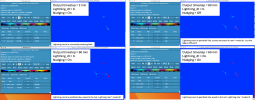In WRF v4.5.1, is there any reason why the lightning flash counts (CG_FLASHCOUNT and IC_FLASHCOUNT) would only be updating at the model output times? It would seem intuitive that these fields would update whenever the lightning scheme is called (e.g., at every model timestep when lightning_dt=0 in namelist.input). Running a few 1-hour tests, it is evident that the accumulated fields are only updating at the output times. Setting the history_interval = 60 minutes results in discrete, paintball-like plots at forecast hour 1, where the flashcount is equal to exactly the flashrate * model_dt. Setting the history_interval = 2 minutes results in much more smoothly evolving, geophysical-looking fields (and orders of magnitude more lightning!).
In my opinion, it doesn't really make sense for the model output to essentially "ignore" light rates and flashcounts between output times, as that seems like it would yield an extreme undercounting of lightning (as well as spatial discontinuities). Moreover, this would suggest that the description of the lightning_dt namelist option is a huge misnomer.
Attached a comparison of some tests I've run to demonstrate the issue (also noting that turning fdda nudging on/off changes flash rates). Relevant lightning namelist settings below:
lightning_option = 2,
iccg_method = 2,
iccg_prescribed_num = 3,
iccg_prescribed_den = 1,
cldtop_adjustment = 0,
lightning_dt = 0, ! or 24
lightning_start_seconds = 600,
flashrate_factor = 1.0,
cellcount_method = 2,
--Kevin
In my opinion, it doesn't really make sense for the model output to essentially "ignore" light rates and flashcounts between output times, as that seems like it would yield an extreme undercounting of lightning (as well as spatial discontinuities). Moreover, this would suggest that the description of the lightning_dt namelist option is a huge misnomer.
Attached a comparison of some tests I've run to demonstrate the issue (also noting that turning fdda nudging on/off changes flash rates). Relevant lightning namelist settings below:
lightning_option = 2,
iccg_method = 2,
iccg_prescribed_num = 3,
iccg_prescribed_den = 1,
cldtop_adjustment = 0,
lightning_dt = 0, ! or 24
lightning_start_seconds = 600,
flashrate_factor = 1.0,
cellcount_method = 2,
--Kevin

